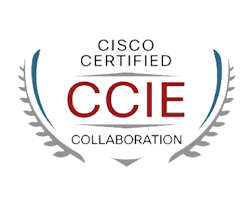
Overview
The Cisco CCIE Collaboration certification course provides essential knowledge and skills in delivering collaboration solutions, configuration, and troubleshooting in complex networks, as well as the challenges of video, mobility, and presence as the foundation for workplace collaboration solutions.
This certification is intended for Collaboration Architects, Unified Communications Architects, or Voice and Video Network Managers who are in charge of the design, implementation, and troubleshooting of complex collaboration solutions.
The CCIE Collaboration Written Exam (400-051) is a two-hour exam that validates the necessary skills for planning, designing, implementing, operating, and troubleshooting enterprise collaboration and communication networks.
CCIE Collaboration 400-051 Exam
The CCIE Collaboration 400-051 Certification Exam Version 2.0 exam aims to combine written and lab exam topic documents into a single curriculum, while explicitly stating which domains apply to which exam and the relative weight of each domain.
- There are no formal requirements for obtaining CCIE certification. There are no other professional certifications or training courses required. Instead, candidates must first pass a written qualification exam, followed by a hands-on lab exam.
- Before attempting certification, you are expected to have a thorough understanding of the topics covered on the exams and are strongly advised to have three to five years of job experience.
- Architects of Collaboration, Architects of Unified Communications, or Architects of Unified Communications
- Managers of Voice and Video Networks
Every two years, CCIEs are required to recertify.
- Earn the necessary credits by participating in the Cisco Continuing Education Program, or
- Obtain a passing score on any current CCIE Written Exam OR CCIE Lab Exam, or
- Pass the most recent CCDE Written Exam OR the most recent CCDE Practical Exam, or
- To extend lower certifications, you must pass both the Cisco Certified Architect (CCAr) interview and the CCAr board review.
If you do not complete your recertification by the deadlines, your CCIE certification will be suspended, and you and your organization will forfeit the advantages of being an expert. After that, you have one year to reactivate your CCIE status before becoming inactive and having to start the certification process all over again.
Having a CCIE Collaboration Certification shows hiring employers that you are educated and dependable in your profession.
Certification leads to more job opportunities, promotions, and higher pay. The current annual average salary for CCIE Collaboration jobs is $130,067.
EXAM FORMAT AND INFORMATION
Exam Name | CCIE Collaboration |
Exam Duration | 120 minutes |
Eligibility/Pre-Requisite | NIL |
Exam Language | English |
Exam Code | 400-051 |
Exam Format | Multiple Choice and Multi-Response Questions |
Total Questions | 90-110 |
Exam Cost | $450 USD |
Register | Pearson VUE |
Step One: CCIE Collaboration Written Exam
You must first pass the two-hour written qualification exam that covers the technology and applications that form a Cisco Enterprise Collaboration solution before you can schedule the lab exam.
Step Two: CCIE Collaboration Lab Exam
The eight-hour lab exam assesses your ability to set up the collaboration solution in a timed test environment. You must take the CCIE lab exam for the first time within 18 months of passing the CCIE written exam. If you fail the lab exam after passing the writing exam within three years, you must retake the written exam before attempting the lab exam again.
Choose Your Preferred Learning Mode

1-TO-1 TRAINING
Customized schedule Learn at your dedicated hour Instant clarification of doubt Guaranteed to run
ONLINE TRAINING
Flexibility, Convenience & Time Saving More Effective Learning Cost Savings


CORPORATE TRAINING
Anytime – Across The Globe Hire A Trainer At Your Own Pace Customized Corporate Training
COURSE OUTLINE
- Cisco Unified Communications Deployment Models
- User administration
- Cisco Collaboration Solutions IP Routing
- Cisco Collaboration Solutions Virtualization
- Wireless Networking in Cisco Collaboration Solutions
- Services for networks
- Power over Ethernet
- VLAN for voice and data
- Multicast over IP
- IPv6 protocol
- SCCP
- MGCP
- SIP
- 323 and RAS
- CODECs for voice and video
- RTP, RTCP, and SRTP are acronyms for Real-Time Transport Protocol, Real-Time Transport Control Protocol, and Real-Time Transport
- Registration and redundancy of devices
- Device configuration
- Codec preference
- Call characteristics
- Dial strategy
- Information and media sources
- CUCM mobility
- CUCM serviceability and operating system administration
- CUCM disaster recovery
- Dialing ILS/URI
- Control of Call Admission
- SIP and H.323 trunks
- SAF and CCD
- Silent monitoring and call recording
- CUCME
- SRST
- CUE
- Call queuing based on Cisco IOS
- Media resources for Cisco IOS
- CUBIC INCHES
- Protocols for fax and modem
- Signaling in analogue telephony
- Signaling in digital telephony
- Dial Cisco IOS
- SAF/CCD
- IOS CAC
- Accounting for IOS
- Quality of Service: Link Efficiency
- Quality of Service (QoS): Classification and Marking
- Quality of Service: Congestion Management
- Quality of Service: Mediante
- Quality of Service: wireless QoS
- Cluster security: mixed mode
- Safety: phone connectivity is encrypted.
- Security: Pre-installed security features
- Security: firewall circumvention
- Security: toll evasion
- Integration of CUCM and CUCME
- A solitary inbox
- MWI
- Call takers
- Dialing plan for 6.5 CUC
- Handlers for directories
- CUC characteristics
- Networking for voicemail
- Integration of UCCX CTI
- ICD features
- UCCX scripting elements
- Components of Cisco Unified IM Presence
- Integration of CUCM
- Cisco Jabber
- Federalism
- Cloud Solutions for Presence
- Group chat and conformity
- The cloud
- Programmability of the network (SDN)
- Internet of Things (IoT)
Get In TOUCH
Frequently Asked Questions

The CCIE Collaboration Certification is intended to improve a candidate’s ability to design, deploy, and manage complex collaboration solutions. This is an expert-level certification that ensures candidates have the necessary knowledge and experience in the integration and interoperability of collaboration solutions.
Among all certifications, CCIE R&S and CCIE Security are in high demand and will continue to be so in the future.
Since its inception in 1993, the CCIE has been regarded as the most difficult certification in the IT industry. It is divided into two parts: a written exam and a practical lab test. The CCIE certification is available in five tracks: routing and switching, security, service provider, storage networking, and voice.
You must pass two exams to earn your CCIE Collaboration Certification: a written qualifying exam and a hands-on lab exam.
CCIE Collaboration candidates are frequently Collaboration Architects, Unified Communications Architects, or Voice and Video Network Managers. Their main duties include designing, implementing, and troubleshooting advanced collaboration solutions.
CCIE candidates should have five to seven years of experience creating, deploying, operating, and optimizing collaboration solutions prior to taking the certification, while this is not mandatory.
